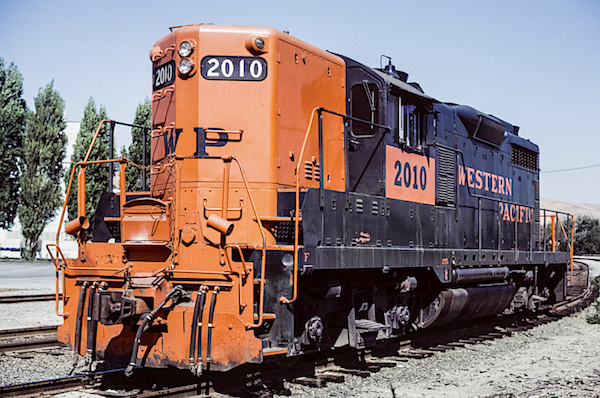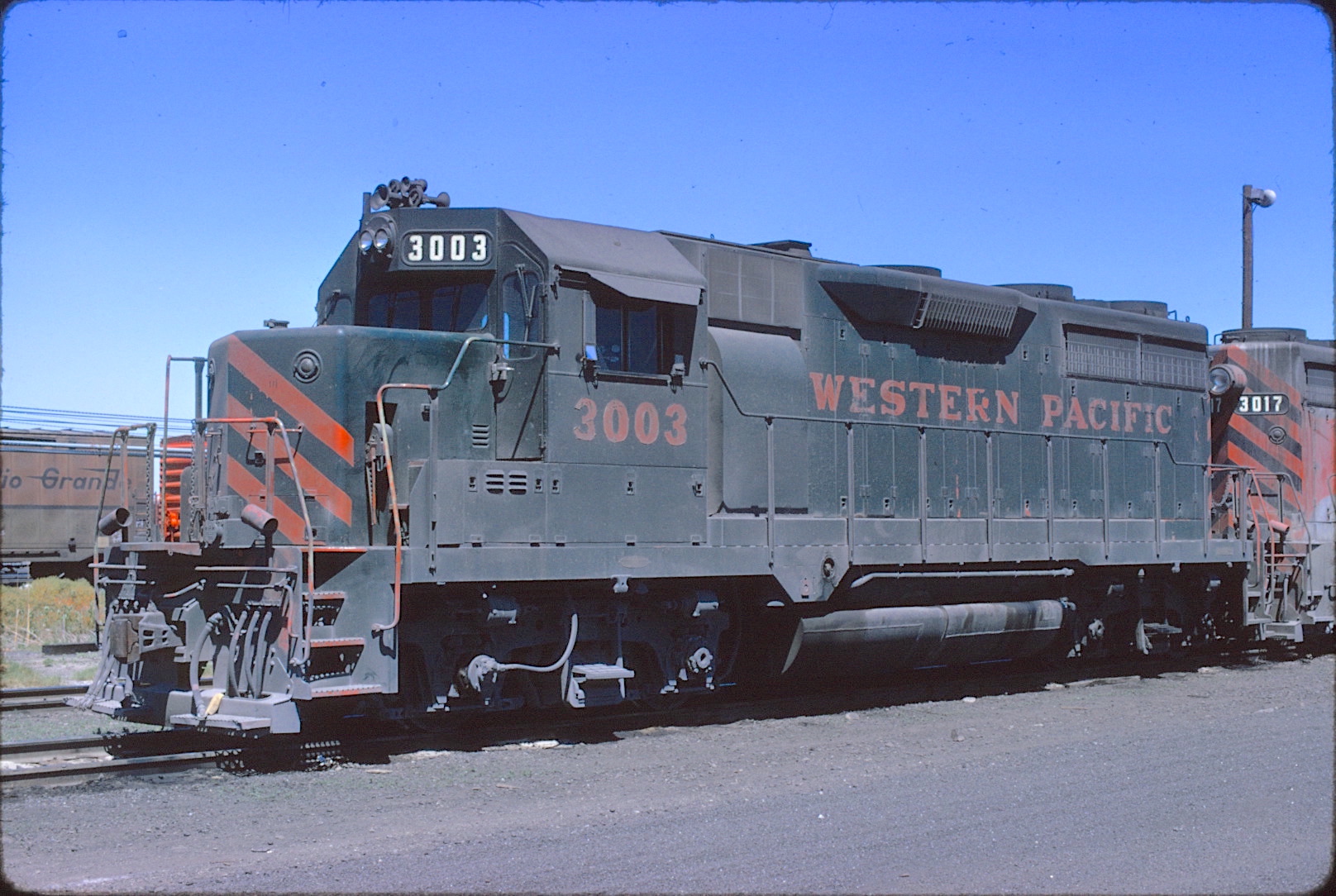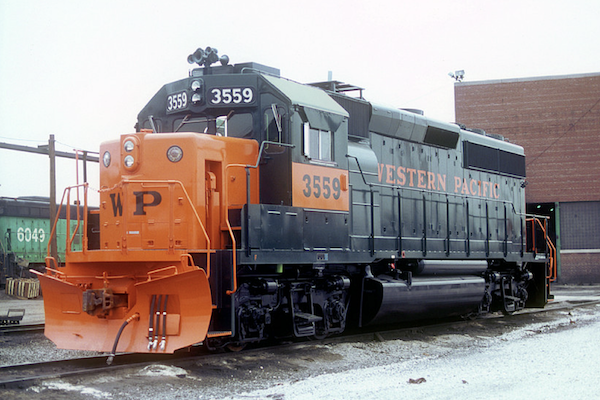Western Pacific in Perlman Green |
|
|---|---|
 |
|
|
Railroading witnessed substantial change as the 1970s got underway. Burlington Northern was
created through the merger of Great Northern, Chicago Burlington & Quincy, Northern Pacific
and Spokane Portland & Seattle merged; Penn Central after struggling financially for two years
collapsed, the U.S. Government shifted the burden of passenger trains from common-carrier
railroads to Amtrak, and in December 1970 long-time railroader and executive Alfred Perlman
took control of the Western Pacific. He was known for railroad revitalization through operation
reform and cost-reduction methodology. Contrary to public thought, WP's shift to green
locomotives had begun months prior to Perlman's arrival on scene; however, the name "Perlman
Green" stuck.
Simplifying the paint scheme to dark green with orange lettering and nose stripes cost the railroad a lot less than the highly popular three-color "California Zephyr" scheme, especially when it came to masking. In later years, locomotive repaints were done in a slightly lighter shade of green with a staggered "WP" on the nose. Actually, the tiger stripe version lasted on most road units until the Union Pacific merger. Western Pacific introduced one final graphics package to the fleet in 1979; it appeared for the first time on the railroad's order for new GP40-2s (#3545-3559) which began arriving at mid-year. Dubbed the "New Image," it featured a bright orange nose and number block beneath the the cab window. Fortunately for many fans, the painting of WP's locomotive fleet proceeded slowly which allowed some units to retain their famed Zephyr silver and orange image for an extended period.
Written by R. Craig with in-put from Ken Rattenne
| |
F7A #921 After a grade crossing incident with a truck in late 1977, the carbody of the #921 was repaired and repainted Perlman green by Morrison-Knudsen. Additionally, a replacement engine was installed and electrical wiring upgraded. (John C. Benson photo / R. Craig Collection) |
GP9 #725 By late 1970s, green paint and orange trim had flowed to all parts of the WP roster, including the vintage geeps. This Marty Bernard shot shows GP9 #725 parked outside the shops in Stockton, California. A sealed-beam replaced the old "barrel" headlight; and footboards were removed. |
GP20 #2010 At a cost approaching $196,000, each of WP's GP20 road-switchers came straight from the EMD factory with a high nose at both ends. They also included dual controls, dynamic braking and M/U capability. The #2010 wears the "new Image" treatment. (Jim Bartolotta photo at Fremont CA, Aug 1981) |
GP35 #3003 Delivered late in 1963, WP 3003 was one of a dozen GP35s on the west coast railroad's roster; it was also the only 2500-hp WP geep to wear at-one-time the company's solid pumpkin orange wardrobe. This Keith Ardinger photo shows the four-axle freight hauler in Salt Lake City, Utah in August 1974. |
GP40 #3520 Built on four separate orders between 1966 and 1971, the railroad's GP40s were ballasted to 69,500 pounds; quite possibly the heaviest four-axle locomotive of any western railroad. The #3520 shown here leads three hi-nose geeps pass Niles Jct Tower in Fremont, California on 2 September 1974. (Rattenne Transportation Archive) |
GP40-2 #3559 Fresh from the factory and enroute to new owner, WP 3559 waits outside the CB&Q diesel shop in Cicero, Illinois in early April 1980. Sporting the railroad's "new Image." the 3000-hp GP40-2 was the last new locomotive purchased by the WP prior to being absorbed by "Uncle Pete." (Chuck Zeiler photo) |
GE #304 When showcasing its 3300-hp on the WP in September 1967, GE U33B demonstrator #304 rode on standard GE trucks, but when purchased by WP as #771 the loco was returned to ts original 3000-hp and given two-axle Blomberg trucks. (R. Craig collection) |
U30B #771 Western Pacific purchased two of GE's well-traveled U30B demonstrators during the summer of 1971. Ex-GE 303 & 304 (WP 770 & 771 respectively) were delivered in Perlman green rather than aluminum and silver. (Joe Brockmeyer photo / R. Craig collection) |
U23B #2255 From WP's first order of U23Bs comes this shot of #2255 approaching Stockton, CA. In the waning days of 1981, this pair of U-boats are detouring along the rails of WP subsidiary Sacramento Northern at milepost 107. (Jim Lekas photo / Rattenne Transportation Archive) |
U23B #2253 Two years prior to succumbing to the influence of Union Pacific and donning armour yellow, the GE-built #2253 stood outside the Stockton, California roundhouse sporting a fresh "New Image" livery. (Photo by James Nelson in March 1981. |
U30B #3051 EMD's had been hauling WP tonnage for more than twenty-five years, and management was partial to the builder's 2-axle Blomberg truck. Hence all GE road units also rode atop Blombergs. The reason was two-fold: The trucks had come from WP geep and F-unit trade-ins and the approach helped the railroad keep parts inventory to a minimum. (Steve Sloan photo / R. Craig collection) |
U30B #3062 By the mid-1960s, WP desperately needed locomotives with a higher continuous effort; and GE's new U30B were the answer. In addition, GE's four-cycle engine saved fuel in contrast to a comparable two-cycle EMD engine. Hence, the railroad placed orders for nineteen U30Bs, and later purchased two ex-demonstrators. (Keith Ardinger photo / R. Craig collection) |
S4 #563 During a 22-year tenure on the WP, Alco #563 had the distinction of being only one of two diesels to wear each of the railroad's four corporate uniforms. The four-axle switcher was delivered in a black dip paint, and returned later to the shops for aluminum and silver colors, followed by a stint in the solid pumpkin attire. (Steven Ewald photo) |
SW9 #605 Locomotive visibility and grade-crossing safety are always an important discussion topic within the railroad industry, and the WP seemed to have developed an ideal graphic solution with custom-painted SW9 #605. However, the one-of-a-kind experiment seen here at Stockton, CA on 20 November 1980 was never duplicated. (Rattenne Transportation Archive) |
SW1500 #1502 Prior to the arrival of three new SW1500s (#1501-1503) in May 1973, it had been 20+ years since the WP had ordered new yard switchers. The trio rode atop flexicoil trucks and were equipped with M/Us compatible with all company road power. #1502 is shown at 25th st. yard in San Francisco on 2 April 1984. (Rattenne Transportation Archive) |
Business Car #1 When it came to Perlman Green, Western pacific managers were all-in. This Mark Lagomarcino photo of Business Car #1 is submitted as further evidence. The six-axle officers car was ex-Union Pacific #109; it was acquired by WP during 1971. The car was one of two operated by WP, but the only one to receive the green and orange. (Krambles-Peterson Archive) |
WP: Epilogue | |
WP/UP #3532 Only a single unit was painted armor yellow with WP lettering, and it was done primarilly for publicity purposes. In July 1983, photographer Norm Holmes captured GP40 #3532 on the first "Family Days" train to operate on the former WP at Portola, CA. (Rattenne Transportation Archive) |
GE Super 7-B23 #2000 Rebuilt in March 1989, ex-WP #2263 was the prototype for General Electric's new "Super 7-23B" line of locomotives. This shot of the GECX prototype was taken in Toledo, Ohio, while it and sister #2001 briefly spent time on Conrail as demonstrators. (R. Craig photo, 22 August 1989) |
Acknowledgements
|
| New: 1 August 2024 | |
